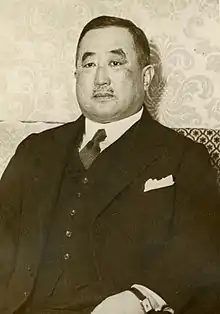Tsuneo Matsudaira | |
|---|---|
 Matsudaira in 1932 | |
| President of the House of Councillors | |
| In office 1947–1949 | |
| Preceded by | Iemasa Tokugawa (as President of the House of Peers) |
| Succeeded by | Naotake Satō |
| Personal details | |
| Born | April 17, 1877 Tokyo, Empire of Japan |
| Died | November 14, 1949 (aged 72) Tokyo, Allied-Occupied Japan |
| Spouse | Nobuko Nabeshima |
| Children | Setsuko, Princess Chichibu Matsudaira Ichiro |
| Parent | Matsudaira Katamori (father) |
Tsuneo Matsudaira (松平 恒雄, Matsudaira Tsuneo, April 17, 1877 – November 14, 1949) was a Japanese diplomat and politician who served as the first President of the House of Councillors from 1947 to 1949. He previously served as Ambassador to the United States from 1924 to 1928, to Britain from 1929 to 1936, and Minister of the Imperial Household from 1936 to 1945.
Early life and career
Tsuneo Matsudaira was born on April 17, 1877, as the sixth son of Katamori Matsudaira, former daimyo of Aizu. Katamori was a prominent Tokugawa loyalist in the Boshin War, but had been shown clemency and later became a priest. The eldest son Kataharu took over the family headship and became a viscount when the nobility was reorganised in 1884.[1]
After attending Gakushuin and the First Higher School, Matsudaira studied law and politics at Tokyo Imperial University. He graduated in 1902 and entered the Ministry of Foreign Affairs. In 1906 he married Nobuko Nabeshima, the daughter of Marquis Naohiro Nabeshima. It was a particularly prestigious connection as her older sister had married Prince Nashimoto. Rising quickly in the Ministry, Matsudaira became director general of the European and American Affairs Bureau in 1920. He was promoted to Vice Minister for Foreign Affairs in 1923, before being appointed Ambassador to the United States the following year.[1]
Imperial marriage

After he was called back to Japan in 1928, the Empress Dowager Teimei arranged for his daughter Setsuko to marry her second son Prince Chichibu. The wedding was celebrated in September.[1]
Matsudaira was then sent to London as Ambassador to Britain from 1929. In that capacity he represented his country at the London Conference on Naval Armaments in 1930. During that conference, he was convinced to accept the ratio in ships which appeared humiliating to the Japanese government through the persuasion efforts of one of the US delegates, Senator David A. Reed, who in return agreed to grant the Japanese government better terms on non-combatant ships.[2][3]
He returned to Japan in 1935. In October his second daughter Masako married the heir of Marquis Yoshichika Tokugawa and in December his son Ichiro married the daughter of Prince Iemasa Tokugawa.[1]
After the Lord Keeper of the Privy Seal Makoto Saito was assassinated in the February 26 incident of 1936, the Minister of the Imperial Household Yuasa Kurahei was appointed to succeed him. Matsudaira was appointed to take over as Minister of the Imperial Household. He served in this position until June 1945, when he resigned to take responsibility the destruction a part of the Imperial Palace in the American firebombing of Tokyo. During the last year of the war he was among the Japanese leaders who acknowledged that the war was lost and suggested searching for early surrender.[4]
Post-war political career
When the Ichiro Hatoyama was purged on the verge on becoming prime minister following the 1946 general elcetion Matsudaira was considered as a candidate to replace him, but Shigeru Yoshida was chosen instead.[1][5]
In 1946 Matsudaira was appointed to the Privy Council, but this body was abolished when the 1947 constitution came into effect. Under the new constitution he was elected in the 1947 House of Councillors election. He formed the Ryokufūkai with other independents and was elected as the first President of the House. He died of a heart attack on November 14, 1949, at the age of 72. His tomb is in Aoyama Cemetery.[1]
Honors
From the corresponding Japanese Wikipedia article
Japanese decorations
- Grand Cordon of the Order of the Sacred Treasure (31 May 1924; Second Class: 1 November 1920; Third Class: 28 June 1919)
- Grand Cordon of the Order of the Rising Sun (11 April 1931; Fourth Class: 1 April 1916; Fifth Class: 24 August 1911; Sixth Class: 1 April 1906)
Works
- Matsudaira, Tsuneo. "Sports and Physical Training in Modern Japan," Transactions and Proceedings of the Japan Society, London, 8 (1907/1909), 120
Ancestry
| Ancestors of Tsuneo Matsudaira[6] | |||||||||||||||||||||||||||||||||||||||||||||||||||||||||||||||||||||||||||||||||||||||||||||||||||||||||||||||||||||||||||||||||||||||||||||||||||||||||||||||||||||||||||||||||||||||||||||||||||||||||||||||||||||||||||||||||||||||||||||||||||||||||||||||||||||||||||||||||||||||||||||||||||||||||||||||||||||||||||||||||||||||||||||||||||||||||||||||||||||||||||||||||||||||||||||||||||||||||||||||||||||||||||||||||||||||||||||||||||||||||||||||||||||||||||||||||||
|---|---|---|---|---|---|---|---|---|---|---|---|---|---|---|---|---|---|---|---|---|---|---|---|---|---|---|---|---|---|---|---|---|---|---|---|---|---|---|---|---|---|---|---|---|---|---|---|---|---|---|---|---|---|---|---|---|---|---|---|---|---|---|---|---|---|---|---|---|---|---|---|---|---|---|---|---|---|---|---|---|---|---|---|---|---|---|---|---|---|---|---|---|---|---|---|---|---|---|---|---|---|---|---|---|---|---|---|---|---|---|---|---|---|---|---|---|---|---|---|---|---|---|---|---|---|---|---|---|---|---|---|---|---|---|---|---|---|---|---|---|---|---|---|---|---|---|---|---|---|---|---|---|---|---|---|---|---|---|---|---|---|---|---|---|---|---|---|---|---|---|---|---|---|---|---|---|---|---|---|---|---|---|---|---|---|---|---|---|---|---|---|---|---|---|---|---|---|---|---|---|---|---|---|---|---|---|---|---|---|---|---|---|---|---|---|---|---|---|---|---|---|---|---|---|---|---|---|---|---|---|---|---|---|---|---|---|---|---|---|---|---|---|---|---|---|---|---|---|---|---|---|---|---|---|---|---|---|---|---|---|---|---|---|---|---|---|---|---|---|---|---|---|---|---|---|---|---|---|---|---|---|---|---|---|---|---|---|---|---|---|---|---|---|---|---|---|---|---|---|---|---|---|---|---|---|---|---|---|---|---|---|---|---|---|---|---|---|---|---|---|---|---|---|---|---|---|---|---|---|---|---|---|---|---|---|---|---|---|---|---|---|---|---|---|---|---|---|---|---|---|---|---|---|---|---|---|---|---|---|---|---|---|---|---|---|---|---|---|---|---|---|---|---|---|---|---|---|---|---|---|---|---|---|---|---|---|---|---|---|---|---|---|---|---|---|---|---|---|---|---|---|---|---|---|---|---|---|---|---|---|---|---|---|---|---|---|---|---|---|---|---|---|---|---|---|---|---|---|---|---|---|---|---|---|---|---|---|---|---|---|---|---|---|---|---|---|---|---|---|---|---|---|---|---|---|---|---|---|---|---|---|---|---|---|---|---|---|
| |||||||||||||||||||||||||||||||||||||||||||||||||||||||||||||||||||||||||||||||||||||||||||||||||||||||||||||||||||||||||||||||||||||||||||||||||||||||||||||||||||||||||||||||||||||||||||||||||||||||||||||||||||||||||||||||||||||||||||||||||||||||||||||||||||||||||||||||||||||||||||||||||||||||||||||||||||||||||||||||||||||||||||||||||||||||||||||||||||||||||||||||||||||||||||||||||||||||||||||||||||||||||||||||||||||||||||||||||||||||||||||||||||||||||||||||||||
References
- 1 2 3 4 5 6 Nish, Ian. Japanese Envoys in Britain, 1862-1964. Global Oriental. p. 153-162. ISBN 9004213457.
- ↑ William Braisted (1991) "On the General Board of the Navy, Admiral Hilary Jones, and Naval Arms Limitation, 1921–1931" The Dwight D. Eisenhower Lectures in War & Peace, No. 4, Kansas State University "Eisenhower Lecture #5: William Braisted". Archived from the original on 2012-03-21. Retrieved 2010-03-23.
- ↑ Van John Sant; Peter Mauch; Yoneyuki Sugita (1 March 2010). The A to Z of United States-Japan Relations. Scarecrow Press. p. 165. ISBN 978-1-4617-2039-3.
- ↑ United States Strategic Bombing Survey, Japan's Struggle to End the War, p. 3
- ↑ Juha Saunavaara (2009). "Occupation Authorities, the Hatoyama Purge and the Making of Japan's Postwar Political Order". The Asia-Pacific Journal. 7 (39).
- ↑ "Genealogy". Reichsarchiv (in Japanese). Retrieved 2 November 2017.
External links
 Media related to Tsuneo Matsudaira at Wikimedia Commons
Media related to Tsuneo Matsudaira at Wikimedia Commons- (in Japanese)Japanese Wiki article on Tsuneo Matsudaira
- Timeline of Tsuneo's life
- Chichibu, Princess Setsuko. The Silver Drum.